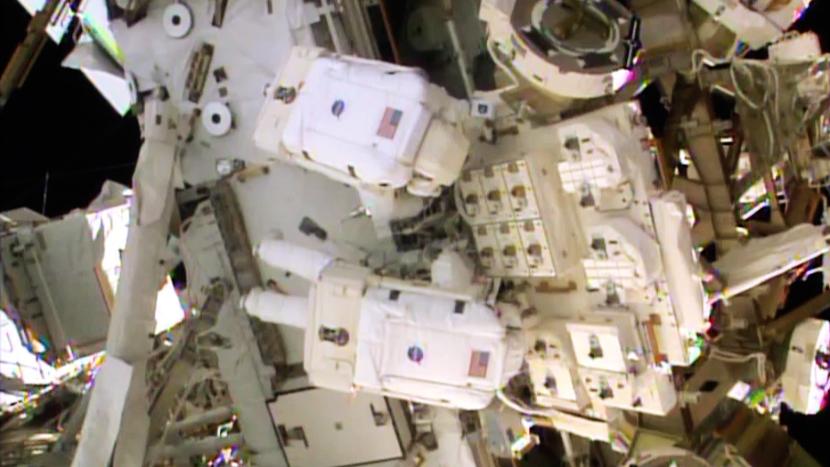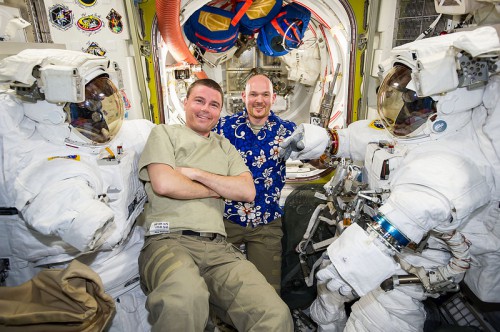
For the first time in more than two decades, two first-time spacefarers embarked together on their first career spacewalks, wearing U.S.-built Extravehicular Mobility Units (EMUs), when NASA astronaut Reid Wiseman and Germany’s Alexander Gerst spent six hours and 13 minutes outside the International Space Station (ISS) on Tuesday, 7 October. The two men departed the Quest airlock a little later than intended, at 8:30 a.m. EDT, but worked swiftly and remained ahead of the timeline, moving a failed pump module from a temporary to long-term storage location, replacing a failed camera light, and installing a new Relay Assembly to provide power redundancy for the railroad-like Mobile Transporter (MT), along which the 57.7-foot (17.4-meter) Canadarm2 robotic arm traverses between its various work sites. At the controls of the “Big Arm” for EVA-27 was fellow Expedition 41 astronaut Barry “Butch” Wilmore, who served as the “Intravehicular” (IV) crewman, working from the multi-windowed cupola.
The primary task of today’s spacewalk became necessary following last December’s automatic shutdown of an ammonia pump module on one of the station’s two coolant loops. Suspicion centered upon the improper functionality of a regulating flow control valve inside the pump module and NASA engineers transferred certain systems over to the second loop and powered down a number of non-critical elements of the Harmony node and Europe’s Columbus and Japan’s Kibo laboratory modules. Since the valve itself was inaccessible to spacewalkers, the sole option was to remove the entire pump module from its location on the starboard S-1 truss and replace it, which Expedition 38 astronauts Rick Mastracchio and Mike Hopkins did during the 5.5-hour EVA-24 on 21 December and the 7.5-hour EVA-25 last Christmas Eve.
As intended, the failed pump module was moved from the S-1 truss and attached to a robotically-controlled stowage location, known as the Payload Orbital Replacement Unit (ORU) Accommodation (POA) on the station’s Mobile Base System (MBS). This was always intended as a temporary stowage point, with forward plans to stage another EVA—originally scheduled for August 2014, during Expedition 40, but delayed due to problems with EMU Long Life Batteries (LLBs)—to move the failed pump module for more permanent storage at External Stowage Platform (ESP)-2, which lies on the starboard side of the U.S. Destiny laboratory module, close to the Quest airlock.

Final preparations for EVA-27 began in the small hours of Tuesday morning, when Wiseman and Gerst jumped onto a well-trodden path of 60 minutes of pre-breathing on masks, during which time the Quest airlock’s inner “equipment lock” will be depressed from its “ambient” 14.7 psi down to 10.2 psi. This pre-breathing protocol was concluded at about 4:30 a.m. EDT. Their next step was donning and purging their bulky EMUs—assisted by a purple-shirted Wilmore—which got underway at 5:50 a.m., after which the atmosphere was repressurized to 14.7 psi.
Wiseman and Gerst then entered a nominal pre-breathing regime, lasting about 50 minutes, followed by another 50 minutes of In-Suit Light Exercise (ISLE). The latter was first trialed on the STS-134 shuttle mission in May 2011 and involved the spacewalkers flexing their knees for about four minutes, resting for one minute, then repeating over and over until the 50 minutes were up. The technique serves to remove nitrogen from the astronauts’ blood streams in a much shorter timeframe.
At 7:45 a.m., Wiseman and Gerst and their equipment—including the Simplified Aid for EVA Rescue (SAFER) units, affixed to the lower section of their life-sustaining backpacks—had been transferred by Wilmore from the equipment lock into Quest’s outer “crew lock.” Hatches between the two locks were closed and depressurization got underway at 7:59 a.m., reaching the 5 psi “hold point” for leak checks at about 8:10 a.m. With no leaks reported, the depressurization process continued until the crew lock had reached a condition of near-vacuum and EVA-27 officially got underway at 8:30 a.m. EDT, when Wiseman and Gerst transitioned their space suits’ critical life-support utilities onto internal battery power.
Pushing open the outer hatch, Wiseman (designated “EV1,” with red stripes adorning the legs of his suit for identification) was first to depart the Quest airlock. He was followed by Gerst (“EV2,” clad in a pure-white suit), who became only the third German citizen, after Thomas Reiter and Hans Schlegel, to perform a spacewalk. Indeed, the black, red, and gold tricolor of the Bundesflagge would be clearly visible throughout the EVA, proudly displayed on the left arm of Gerst’s suit.
By 8:50 a.m.—backdropped by a gorgeous orbital sunrise, which appeared to take both spacewalkers’ breath away—the thermal cover of the airlock had been closed and Wiseman and Gerst set about their first important task: performing “buddy checks” of each other’s suits and safety tethers. They then separated and headed to their respective work sites. Gerst moved to the Starboard Crew and Equipment Translation Aid (CETA) to temporarily stow a pair of equipment bags, in support of the Mobile Transporter Relay Assembly (MTRA) installation, later in the EVA. Meanwhile, Wiseman translated to ESP-2 to prepare for the imminent arrival of the failed pump module. During his transit, he was advised to beware of a Micrometeoroid Orbital Debris (MMOD) impact, which he described as tiny, with no evidence of any sharp edges. Wiseman stowed equipment bags, and, despite minor difficulties attaching tethers, he opened the Multi-Layer Insulation (MLI) thermal cover to accept the 780-pound (350-kg) pump module.

At this stage, Gerst had moved to the Port CETA, and at 9:05 a.m. retrieved the Articulating Portable Foot Restraint (APFR), which he transferred to the Canadarm2 installation point at the interface between the station’s central S-0 truss and the port-side P-1 truss. Shortly before 9:30 a.m., he securely attached the APFR onto the end of the arm and, after exchanging his safety tethers, ingressed the foot restraint a few minutes later. Exulting “Okay, Butch, I’m ready to fly,” he was flown by Wilmore to the POA. He delicately removed the failed pump module, which was free at about 10 a.m., and rotated it through 180 degrees to get it to the correct installation orientation.
Wiseman, meanwhile, had moved the two MTRA equipment bags—one containing the Relay Assembly itself, the other holding its four installation cables—out to the space-facing (or “zenith”) face of the MT. He then relocated himself to Gerst’s safety tether, gathered it, and moved to ESP-2 to await the arrival of the pump module. Working about 15 minutes ahead of the timeline, the Canadarm2-riding Gerst swiftly joined him and proceeded to insert the pump module into its ESP-2 permanent stowage location. With Wiseman providing an extra pair of eyes, Gerst stopped at the halfway point, as intended, to allow his crewmate to remove the Adjustable Grapple Bar (AGB) from the pump module at 10:55 a.m. This had been used as a grapple fixture to secure it to the POA since last December. With its removal, Gerst was able to drive the pump module fully into place.
Guided by Lead Capcom Doug “Wheels” Wheelock from Mission Control, the two spacewalkers made short work of securing the pump module in place by means of four bolts, which was complete by 11:10 a.m. They stowed the AGB onto a spare ORU at the ESP-2 work site and set about their next tasks. Wiseman remained at ESP-2 to clean up the location, closing the thermal cover over the pump module by 12:00 p.m., and moving equipment bags back to the airlock. He then translated to the zenith face of the MT to begin the Relay Assembly installation. This location afforded Wiseman a spectacular “forward” perspective, over much of the U.S. Orbital Segment (USOS), although there was precious little time to admire the view. Using a Pistol Grip Tool (PGT), he installed the MTRA, which provides backup power options for the MT, then routed and mated electrical cables to its Earth-facing (or “nadir”) surface.
Independently of his crewmate, Gerst had dispensed his own tasks with seemingly effortless ease, replacing a failed light at External Camera Port 13, on the starboard side of the Destiny module. “That light has one of two bulbs currently failed in it,” explained Scott Stover, who served as Lead Flight Director for EVA-27, “and it’s one of our primary lights that we use for the visiting vehicles…and also for external robotics. We want to go out and replace that light before the second bulb fails.” Carrying the spare light in an equipment bag, Gerst was flown by Wilmore on Canadarm2 to the work site, where he removed the old light, fitted the new one, and secured it with a single bolt and electrical connector. Germany’s third spacewalker then stowed the APFR and by 12:35 p.m. had removed himself from Canadarm2 and translated back to the airlock to stow the failed camera light.

In the meantime, at the MT work site, Wiseman soft-docked the Relay Assembly and was joined later by Gerst. Still operating ahead of the timeline, Wiseman worked on the port side of the MTRA and Gerst the starboard side, routing cables to the nadir location, then returning to the zenith location, securing all wire ties as they went to keep them from obstructing the MT’s translation path. The task was completed by 2:05 p.m.—five hours and 35 minutes into the scheduled 6.5-hour EVA—and as Wiseman and Gerst cleaned up their work site, Mission Control entered discussions about having them press ahead into several “get-ahead” tasks. However, by 2:20 p.m., as EVA-27 edged toward the six-hour mark, it was decided that no get-aheads would be performed and the spacewalk drawn to a close.
Entering the Quest airlock, Wiseman closed the outer hatch behind himself and Gerst at 2:31 p.m., and the process of repressurization got underway at 2:43 p.m., officially ending EVA-27 after six hours and 13 minutes.
Next up is EVA-28, currently planned for Wednesday, 15 October, and featuring Wiseman (EV1) and Wilmore (EV2). During their 6.5-hour spacewalk, the astronauts will replace a Sequential Shunt Unit (SSU) on the station’s starboard truss, which failed back in May 2014. Wiseman and Wilmore will also relocate external cameras in support of next year’s arrival of the first International Docking Adapters (IDAs) for the long-awaited Commercial Crew vehicles. According to Space Station Integration Operations Manager Kenny Todd, these EVAs mark the beginning of a salvo of spacewalks which will run into the spring and summer of 2015. Mr. Todd stressed that the two contingency EVAs last December and also a third unplanned spacewalk in April 2014 by Expedition 39’s Rick Mastracchio and Steve Swanson “had left some things out there that we knew we wanted put back in proper order.” He added that there was an urgent need to tend to power-related issues and improve the station’s fault-tolerant capability, ahead of several more complex EVAs next year.
Current plans call for two U.S. spacewalks in January 2015, two others in April and June, and a further pair in August to route cables and utilities in support of the relocation of the Leonardo Permanent Multipurpose Module (PMM) and the Pressurized Mating Adapter (PMA)-3. This will lay the groundwork for the delivery of two International Docking Adapters (IDAs) in support of Boeing’s CST-100 and SpaceX’s Dragon V2 Commercial Crew vehicles. The Leonardo PMM will be robotically transferred in July 2015 from the nadir port of the Unity node to the forward port of the Tranquility node, whilst PMA-3 will be moved in the late August timeframe from its current berth on Tranquility to the zenith port of the Harmony node for Commercial Crew operations.
Want to keep up-to-date with all things space? Be sure to “Like” AmericaSpace on Facebook and follow us on Twitter: @AmericaSpace



